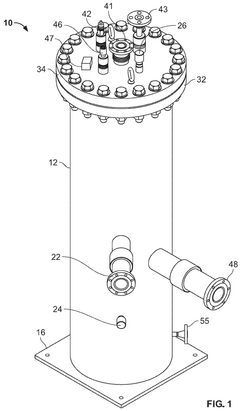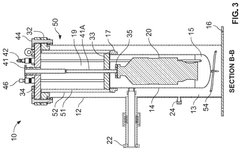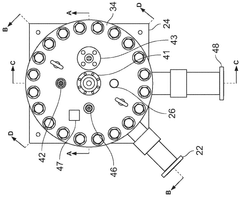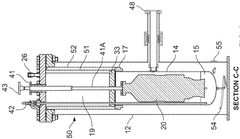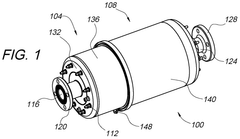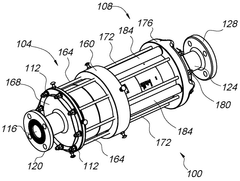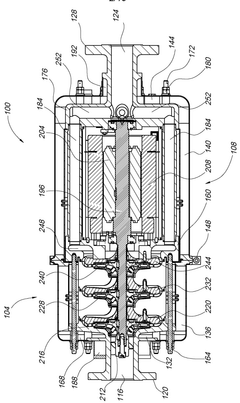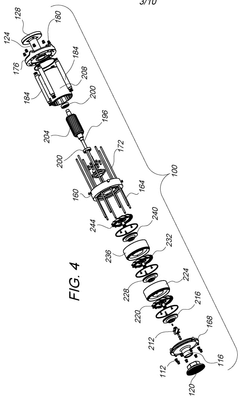Submersible pumps in cryogenic liquid applications.
JUL 15, 20259 MIN READ
Generate Your Research Report Instantly with AI Agent
Patsnap Eureka helps you evaluate technical feasibility & market potential.
Cryogenic Pump Evolution
The evolution of cryogenic pumps for submersible applications in liquefied gases has been marked by significant technological advancements over the past decades. Initially, cryogenic pump designs were adapted from conventional pump technologies, with modifications to handle the extreme low temperatures and unique fluid properties of cryogenic liquids.
In the early stages, centrifugal pumps were the primary choice for cryogenic applications. These pumps underwent substantial modifications to address the challenges posed by cryogenic environments, such as thermal contraction, material brittleness, and cavitation. Engineers focused on developing specialized materials capable of withstanding extreme temperature fluctuations and maintaining structural integrity in cryogenic conditions.
The 1960s and 1970s saw a shift towards the development of submerged motor pumps specifically designed for cryogenic liquids. This innovation eliminated the need for long shafts and complex sealing systems, reducing heat ingress and improving overall efficiency. The integration of the motor and pump within the cryogenic fluid marked a significant milestone in pump design, allowing for more compact and reliable systems.
As the demand for larger-scale liquefied natural gas (LNG) operations grew in the 1980s and 1990s, cryogenic pump technology evolved to meet the requirements of higher flow rates and increased reliability. Multi-stage centrifugal pumps became more prevalent, offering improved efficiency and the ability to handle varying flow conditions in LNG transfer applications.
The turn of the millennium brought advancements in materials science and computational fluid dynamics, enabling more sophisticated pump designs. High-performance alloys and composite materials were introduced, offering superior resistance to thermal stress and wear. Computational modeling allowed for optimized impeller and volute designs, further enhancing pump efficiency and reducing the risk of cavitation.
Recent years have seen a focus on developing smart cryogenic pumps with integrated sensors and control systems. These innovations allow for real-time monitoring of pump performance, predictive maintenance, and automatic adjustment to changing operating conditions. The integration of IoT technologies has enabled remote monitoring and control, improving the overall reliability and operational efficiency of cryogenic pump systems.
The evolution of cryogenic pumps has also been driven by the growing emphasis on energy efficiency and environmental considerations. Modern designs incorporate features to minimize heat ingress, reduce power consumption, and optimize performance across a wide range of operating conditions. This has led to the development of variable speed drives and advanced control algorithms tailored specifically for cryogenic applications.
In the early stages, centrifugal pumps were the primary choice for cryogenic applications. These pumps underwent substantial modifications to address the challenges posed by cryogenic environments, such as thermal contraction, material brittleness, and cavitation. Engineers focused on developing specialized materials capable of withstanding extreme temperature fluctuations and maintaining structural integrity in cryogenic conditions.
The 1960s and 1970s saw a shift towards the development of submerged motor pumps specifically designed for cryogenic liquids. This innovation eliminated the need for long shafts and complex sealing systems, reducing heat ingress and improving overall efficiency. The integration of the motor and pump within the cryogenic fluid marked a significant milestone in pump design, allowing for more compact and reliable systems.
As the demand for larger-scale liquefied natural gas (LNG) operations grew in the 1980s and 1990s, cryogenic pump technology evolved to meet the requirements of higher flow rates and increased reliability. Multi-stage centrifugal pumps became more prevalent, offering improved efficiency and the ability to handle varying flow conditions in LNG transfer applications.
The turn of the millennium brought advancements in materials science and computational fluid dynamics, enabling more sophisticated pump designs. High-performance alloys and composite materials were introduced, offering superior resistance to thermal stress and wear. Computational modeling allowed for optimized impeller and volute designs, further enhancing pump efficiency and reducing the risk of cavitation.
Recent years have seen a focus on developing smart cryogenic pumps with integrated sensors and control systems. These innovations allow for real-time monitoring of pump performance, predictive maintenance, and automatic adjustment to changing operating conditions. The integration of IoT technologies has enabled remote monitoring and control, improving the overall reliability and operational efficiency of cryogenic pump systems.
The evolution of cryogenic pumps has also been driven by the growing emphasis on energy efficiency and environmental considerations. Modern designs incorporate features to minimize heat ingress, reduce power consumption, and optimize performance across a wide range of operating conditions. This has led to the development of variable speed drives and advanced control algorithms tailored specifically for cryogenic applications.
Market Demand Analysis
The market demand for submersible pumps in cryogenic liquid applications has been experiencing significant growth in recent years. This surge is primarily driven by the expanding use of liquefied natural gas (LNG) and other cryogenic fluids in various industries, including energy, healthcare, and aerospace.
In the energy sector, the global shift towards cleaner fuel sources has led to increased LNG production and transportation. This trend has created a substantial demand for specialized submersible pumps capable of handling extremely low-temperature liquids. The LNG market is projected to grow at a compound annual growth rate (CAGR) of 5.8% from 2021 to 2028, indicating a parallel increase in demand for cryogenic submersible pumps.
The healthcare industry also contributes to the market demand, particularly in the storage and handling of liquid nitrogen for cryogenic preservation of biological samples and in medical imaging equipment. As advanced medical technologies become more widespread, the need for reliable cryogenic pumping solutions continues to rise.
Aerospace and space exploration sectors represent another significant market for cryogenic submersible pumps. These industries require highly specialized pumps for handling liquid hydrogen and liquid oxygen in rocket propulsion systems. With the increasing number of space missions and satellite launches, the demand for cryogenic pumps in this sector is expected to grow steadily.
The industrial gas market, which includes the production and distribution of gases like nitrogen, oxygen, and argon in their liquid form, also drives the demand for cryogenic submersible pumps. This market is forecasted to reach $92.1 billion by 2026, with a CAGR of 6.0% from 2021 to 2026.
Geographically, Asia-Pacific is emerging as a key market for cryogenic submersible pumps, driven by rapid industrialization and increasing LNG infrastructure development in countries like China and India. North America and Europe continue to be significant markets, with established LNG facilities and ongoing research in cryogenic technologies.
The market demand is not only focused on the quantity of pumps but also on their quality and efficiency. End-users are increasingly seeking pumps with higher reliability, lower maintenance requirements, and improved energy efficiency. This trend is pushing manufacturers to invest in research and development to create more advanced and durable cryogenic submersible pump solutions.
However, the market also faces challenges that could impact demand. The high initial cost of cryogenic equipment and the complexity of handling ultra-low temperature liquids pose barriers to entry for some potential users. Additionally, safety concerns and stringent regulations surrounding cryogenic operations can influence market growth rates.
In the energy sector, the global shift towards cleaner fuel sources has led to increased LNG production and transportation. This trend has created a substantial demand for specialized submersible pumps capable of handling extremely low-temperature liquids. The LNG market is projected to grow at a compound annual growth rate (CAGR) of 5.8% from 2021 to 2028, indicating a parallel increase in demand for cryogenic submersible pumps.
The healthcare industry also contributes to the market demand, particularly in the storage and handling of liquid nitrogen for cryogenic preservation of biological samples and in medical imaging equipment. As advanced medical technologies become more widespread, the need for reliable cryogenic pumping solutions continues to rise.
Aerospace and space exploration sectors represent another significant market for cryogenic submersible pumps. These industries require highly specialized pumps for handling liquid hydrogen and liquid oxygen in rocket propulsion systems. With the increasing number of space missions and satellite launches, the demand for cryogenic pumps in this sector is expected to grow steadily.
The industrial gas market, which includes the production and distribution of gases like nitrogen, oxygen, and argon in their liquid form, also drives the demand for cryogenic submersible pumps. This market is forecasted to reach $92.1 billion by 2026, with a CAGR of 6.0% from 2021 to 2026.
Geographically, Asia-Pacific is emerging as a key market for cryogenic submersible pumps, driven by rapid industrialization and increasing LNG infrastructure development in countries like China and India. North America and Europe continue to be significant markets, with established LNG facilities and ongoing research in cryogenic technologies.
The market demand is not only focused on the quantity of pumps but also on their quality and efficiency. End-users are increasingly seeking pumps with higher reliability, lower maintenance requirements, and improved energy efficiency. This trend is pushing manufacturers to invest in research and development to create more advanced and durable cryogenic submersible pump solutions.
However, the market also faces challenges that could impact demand. The high initial cost of cryogenic equipment and the complexity of handling ultra-low temperature liquids pose barriers to entry for some potential users. Additionally, safety concerns and stringent regulations surrounding cryogenic operations can influence market growth rates.
Technical Challenges
The application of submersible pumps in cryogenic liquid environments presents several significant technical challenges. One of the primary obstacles is material selection. Conventional materials used in standard submersible pumps often become brittle or lose their structural integrity when exposed to extremely low temperatures. This necessitates the use of specialized materials that can maintain their mechanical properties and performance under cryogenic conditions, such as austenitic stainless steels or certain nickel alloys.
Thermal management poses another critical challenge. The extreme temperature differentials between the cryogenic liquid and the ambient environment can lead to thermal shock, potentially causing pump failure or compromising its efficiency. Engineers must develop innovative thermal insulation techniques and heat transfer management systems to mitigate these issues and ensure stable pump operation.
Sealing technology is particularly crucial in cryogenic applications. Traditional sealing materials and methods may not be effective at extremely low temperatures, leading to leakage and reduced pump efficiency. Developing reliable sealing solutions that can withstand cryogenic temperatures while maintaining a tight seal is a significant technical hurdle.
The behavior of cryogenic liquids themselves presents unique challenges. Many cryogenic fluids, such as liquid nitrogen or liquid helium, have very low viscosities and densities compared to conventional liquids. This can lead to cavitation issues within the pump, potentially causing damage to impellers and other components. Designers must carefully consider fluid dynamics and optimize pump geometries to prevent cavitation and ensure efficient operation.
Lubrication is another area of concern in cryogenic submersible pumps. Traditional lubricants become ineffective at extremely low temperatures, potentially leading to increased friction and wear on pump components. Developing lubricants that remain effective in cryogenic environments or designing self-lubricating systems is essential for long-term pump reliability.
Instrumentation and control systems face their own set of challenges in cryogenic applications. Sensors and electronic components must be able to function accurately and reliably at extremely low temperatures. This often requires the development of specialized sensors and control systems designed specifically for cryogenic environments.
Lastly, the overall system integration presents a significant challenge. Ensuring that all components of the submersible pump system work together seamlessly in a cryogenic environment requires extensive testing and validation. This includes not only the pump itself but also associated piping, valves, and auxiliary equipment, all of which must be compatible with cryogenic operation.
Thermal management poses another critical challenge. The extreme temperature differentials between the cryogenic liquid and the ambient environment can lead to thermal shock, potentially causing pump failure or compromising its efficiency. Engineers must develop innovative thermal insulation techniques and heat transfer management systems to mitigate these issues and ensure stable pump operation.
Sealing technology is particularly crucial in cryogenic applications. Traditional sealing materials and methods may not be effective at extremely low temperatures, leading to leakage and reduced pump efficiency. Developing reliable sealing solutions that can withstand cryogenic temperatures while maintaining a tight seal is a significant technical hurdle.
The behavior of cryogenic liquids themselves presents unique challenges. Many cryogenic fluids, such as liquid nitrogen or liquid helium, have very low viscosities and densities compared to conventional liquids. This can lead to cavitation issues within the pump, potentially causing damage to impellers and other components. Designers must carefully consider fluid dynamics and optimize pump geometries to prevent cavitation and ensure efficient operation.
Lubrication is another area of concern in cryogenic submersible pumps. Traditional lubricants become ineffective at extremely low temperatures, potentially leading to increased friction and wear on pump components. Developing lubricants that remain effective in cryogenic environments or designing self-lubricating systems is essential for long-term pump reliability.
Instrumentation and control systems face their own set of challenges in cryogenic applications. Sensors and electronic components must be able to function accurately and reliably at extremely low temperatures. This often requires the development of specialized sensors and control systems designed specifically for cryogenic environments.
Lastly, the overall system integration presents a significant challenge. Ensuring that all components of the submersible pump system work together seamlessly in a cryogenic environment requires extensive testing and validation. This includes not only the pump itself but also associated piping, valves, and auxiliary equipment, all of which must be compatible with cryogenic operation.
Current Solutions
01 Design and construction of submersible pumps
Submersible pumps are designed to operate while fully submerged in liquid. Their construction typically includes a sealed motor directly coupled to the pump body, allowing for efficient operation in underwater environments. These pumps are engineered to withstand the pressure and corrosive effects of the liquid they are immersed in, making them suitable for various applications such as well pumping, wastewater management, and offshore operations.- Design and construction of submersible pumps: Submersible pumps are designed to operate while fully submerged in liquid. They typically consist of a sealed motor coupled to a pump body. The design focuses on waterproofing, efficient cooling, and optimizing performance in underwater conditions. Various materials and configurations are used to enhance durability and efficiency in different applications.
- Control systems for submersible pumps: Advanced control systems are implemented to manage and optimize submersible pump operations. These systems may include sensors for monitoring pump performance, water levels, and environmental conditions. They can adjust pump speed, start/stop cycles, and other parameters to improve efficiency and prevent damage. Some systems incorporate remote monitoring and control capabilities.
- Energy efficiency improvements in submersible pumps: Innovations in submersible pump technology focus on enhancing energy efficiency. This includes the development of high-efficiency motors, improved impeller designs, and the use of variable frequency drives. Some designs incorporate energy recovery systems or utilize alternative power sources like solar energy to reduce operational costs and environmental impact.
- Specialized submersible pumps for specific applications: Submersible pumps are adapted for various specialized applications such as deep well pumping, wastewater treatment, offshore oil extraction, and mining operations. These pumps are designed to handle specific fluid types, pressures, and environmental conditions. Features may include abrasion-resistant materials, high-temperature operation capabilities, or the ability to handle solids and corrosive fluids.
- Maintenance and reliability enhancements for submersible pumps: Innovations in submersible pump design focus on improving reliability and ease of maintenance. This includes the development of self-diagnostic systems, modular designs for easy part replacement, and materials that resist wear and corrosion. Some pumps incorporate features that allow for in-situ maintenance or quick removal and reinstallation to minimize downtime.
02 Control systems for submersible pumps
Advanced control systems are implemented in submersible pumps to optimize their performance and efficiency. These systems may include sensors for monitoring pump conditions, variable frequency drives for adjusting motor speed, and intelligent algorithms for predictive maintenance. Such control mechanisms enable remote operation, automatic adjustment to changing conditions, and improved energy efficiency in pump operations.Expand Specific Solutions03 Innovations in submersible pump materials
Material science advancements have led to the development of more durable and efficient submersible pumps. New materials and coatings are being used to enhance corrosion resistance, reduce wear, and improve overall pump lifespan. These innovations allow submersible pumps to operate in more challenging environments and handle a wider range of fluids, including those with abrasive particles or corrosive properties.Expand Specific Solutions04 Energy-efficient submersible pump designs
Recent developments in submersible pump technology focus on improving energy efficiency. This includes optimizing impeller designs, using high-efficiency motors, and implementing smart control systems. These energy-efficient designs not only reduce operational costs but also minimize environmental impact, making them particularly valuable in applications requiring continuous or long-term operation.Expand Specific Solutions05 Specialized submersible pumps for specific applications
Submersible pumps are being tailored for specific industrial and environmental applications. This includes pumps designed for deep-sea oil extraction, geothermal energy production, and handling of specific types of wastewater or chemicals. These specialized pumps often incorporate unique features such as high-pressure capabilities, resistance to extreme temperatures, or the ability to handle multi-phase fluids efficiently.Expand Specific Solutions
Industry Leaders
The research on submersible pumps in cryogenic liquid applications is in a growth phase, with increasing market demand driven by expanding industrial and energy sectors. The global market size for cryogenic pumps is projected to reach several billion dollars by 2025. Technologically, the field is advancing rapidly, with companies like Air Liquide, Linde Gas, and Chart Inc. leading innovation in pump design and efficiency. These industry leaders are focusing on developing pumps with improved performance in extreme low-temperature environments, enhanced reliability, and reduced maintenance requirements. Emerging players such as Acme Cryogenics and Fives Cryomec are also contributing to technological advancements, particularly in specialized applications and custom solutions for cryogenic liquid handling.
Linde Gas AG
Technical Solution: Linde Gas AG has pioneered submersible pump technology for cryogenic applications, focusing on energy efficiency and reliability. Their pumps feature a proprietary low-NPSH (Net Positive Suction Head) design, allowing for operation with minimal liquid head and reducing the risk of cavitation. Linde's pumps incorporate advanced materials such as special stainless steels and composite polymers to withstand extreme low temperatures. The company has also developed a unique shaft sealing system that minimizes heat ingress and prevents gas leakage[2]. Linde's cryogenic pumps are capable of handling liquefied gases at temperatures down to -269°C (liquid helium) and can achieve flow rates of up to 1000 m³/h in larger models[4].
Strengths: Wide temperature range capability, high flow rates, advanced materials for durability. Weaknesses: Complex design may lead to higher maintenance requirements, potentially higher cost.
Dalian Deep Blue Pump Co., Ltd.
Technical Solution: Dalian Deep Blue Pump Co., Ltd. has developed cost-effective submersible pump solutions for cryogenic liquid applications, focusing on reliability and ease of use. Their pumps utilize a simplified design with fewer moving parts, reducing the potential for mechanical failures in extreme low-temperature environments. The company has implemented a proprietary motor insulation system that enhances thermal efficiency and extends operational life. Dalian Deep Blue's pumps feature a unique impeller design optimized for cryogenic fluids, improving overall hydraulic performance[10]. Their technology includes a self-priming capability, allowing for easier start-up in cryogenic applications. The pumps are capable of handling liquefied gases at temperatures down to -196°C (liquid nitrogen) and offer flow rates ranging from 5 to 300 m³/h, catering to a wide range of industrial needs[11].
Strengths: Cost-effective, simplified design for improved reliability, self-priming capability. Weaknesses: May have lower maximum flow rates compared to some competitors, limited to higher temperature cryogenic fluids.
Key Innovations
Submerged pump and SUMP assemblies for use with cryogenic fluids
PatentWO2025085534A1
Innovation
- The development of submerged pump and sump assemblies that provide sufficient insulation to facilitate the use of a submersible pump for cryogenic fluid transfer, while allowing for easy access and maintenance without disassembly.
Submersible cryogenic liquid hydrogen pump assembly
PatentWO2025042790A1
Innovation
- A submersible cryogenic liquid hydrogen pump assembly is designed, comprising a centrifugal pump, an electric induction motor, and an integrated vacuum jacketed housing, which can also operate without vacuum jacketing, using the process fluid for lubrication and cooling, and is configured for vertical submersion in cryogenic storage tanks.
Safety Regulations
Safety regulations play a crucial role in the application of submersible pumps in cryogenic liquid environments. These regulations are designed to protect personnel, equipment, and the environment from potential hazards associated with handling extremely low-temperature fluids.
One of the primary safety concerns in cryogenic applications is the risk of rapid temperature changes, which can lead to material failure or thermal shock. Regulations often mandate the use of materials specifically rated for cryogenic temperatures, such as austenitic stainless steels or certain aluminum alloys. These materials must maintain their mechanical properties and structural integrity under extreme cold conditions.
Insulation requirements are another key aspect of safety regulations for cryogenic submersible pumps. Proper insulation is essential to prevent heat ingress, which can cause rapid boil-off of the cryogenic liquid and potentially lead to pressure build-up. Regulations typically specify the type and thickness of insulation materials to be used, as well as requirements for vapor barriers to prevent moisture condensation.
Pressure relief systems are mandatory in cryogenic pump installations to prevent over-pressurization due to liquid expansion or unexpected vaporization. Safety regulations often dictate the sizing, placement, and maintenance requirements for pressure relief valves and rupture disks. These systems must be designed to handle the maximum expected flow rates and pressures while ensuring safe venting of excess gases.
Personal protective equipment (PPE) regulations are particularly stringent for workers handling cryogenic submersible pumps. This includes requirements for cryogenic-rated gloves, face shields, and protective clothing to prevent cold burns and frostbite. Training programs on the proper use of PPE and safe handling procedures for cryogenic liquids are typically mandated by safety regulations.
Ventilation requirements are another critical aspect of safety regulations in cryogenic applications. Adequate ventilation is necessary to prevent the accumulation of vaporized gases, which can lead to oxygen depletion or, in some cases, create explosive atmospheres. Regulations often specify minimum air exchange rates and the placement of gas detection systems to monitor oxygen levels and potential leaks.
Emergency response procedures are an integral part of safety regulations for cryogenic submersible pump operations. These regulations typically require the development and regular testing of emergency shutdown systems, evacuation plans, and spill response protocols. Facilities must also maintain specialized first-aid equipment and trained personnel capable of responding to cryogenic-related injuries.
Maintenance and inspection regulations ensure the ongoing safety and reliability of cryogenic submersible pump systems. These may include requirements for regular non-destructive testing of pump components, inspection of insulation integrity, and calibration of safety-critical instruments. Documentation and record-keeping requirements are often specified to ensure compliance and traceability of maintenance activities.
One of the primary safety concerns in cryogenic applications is the risk of rapid temperature changes, which can lead to material failure or thermal shock. Regulations often mandate the use of materials specifically rated for cryogenic temperatures, such as austenitic stainless steels or certain aluminum alloys. These materials must maintain their mechanical properties and structural integrity under extreme cold conditions.
Insulation requirements are another key aspect of safety regulations for cryogenic submersible pumps. Proper insulation is essential to prevent heat ingress, which can cause rapid boil-off of the cryogenic liquid and potentially lead to pressure build-up. Regulations typically specify the type and thickness of insulation materials to be used, as well as requirements for vapor barriers to prevent moisture condensation.
Pressure relief systems are mandatory in cryogenic pump installations to prevent over-pressurization due to liquid expansion or unexpected vaporization. Safety regulations often dictate the sizing, placement, and maintenance requirements for pressure relief valves and rupture disks. These systems must be designed to handle the maximum expected flow rates and pressures while ensuring safe venting of excess gases.
Personal protective equipment (PPE) regulations are particularly stringent for workers handling cryogenic submersible pumps. This includes requirements for cryogenic-rated gloves, face shields, and protective clothing to prevent cold burns and frostbite. Training programs on the proper use of PPE and safe handling procedures for cryogenic liquids are typically mandated by safety regulations.
Ventilation requirements are another critical aspect of safety regulations in cryogenic applications. Adequate ventilation is necessary to prevent the accumulation of vaporized gases, which can lead to oxygen depletion or, in some cases, create explosive atmospheres. Regulations often specify minimum air exchange rates and the placement of gas detection systems to monitor oxygen levels and potential leaks.
Emergency response procedures are an integral part of safety regulations for cryogenic submersible pump operations. These regulations typically require the development and regular testing of emergency shutdown systems, evacuation plans, and spill response protocols. Facilities must also maintain specialized first-aid equipment and trained personnel capable of responding to cryogenic-related injuries.
Maintenance and inspection regulations ensure the ongoing safety and reliability of cryogenic submersible pump systems. These may include requirements for regular non-destructive testing of pump components, inspection of insulation integrity, and calibration of safety-critical instruments. Documentation and record-keeping requirements are often specified to ensure compliance and traceability of maintenance activities.
Material Advancements
Material advancements play a crucial role in enhancing the performance and reliability of submersible pumps in cryogenic liquid applications. The extreme low temperatures and harsh operating conditions in cryogenic environments pose significant challenges to traditional materials, necessitating the development of specialized materials that can withstand these demanding conditions.
One of the primary areas of focus in material advancements for cryogenic submersible pumps is the development of low-temperature resistant alloys. These alloys are designed to maintain their mechanical properties and structural integrity at extremely low temperatures, often reaching -196°C or lower. Nickel-based superalloys, such as Inconel 718 and Hastelloy C-276, have shown promising results in cryogenic applications due to their excellent strength, toughness, and corrosion resistance at low temperatures.
Composite materials have also gained significant attention in recent years for their potential in cryogenic pump applications. Fiber-reinforced polymers (FRPs), particularly those utilizing carbon or glass fibers, offer a combination of high strength-to-weight ratio and excellent thermal insulation properties. These characteristics make them ideal for pump components that require both structural integrity and thermal management in cryogenic environments.
Advanced ceramics, such as silicon carbide and alumina, are being explored for their exceptional wear resistance and thermal stability in cryogenic conditions. These materials can be used in critical components like bearings and seals, where traditional metallic materials may fail due to thermal contraction or brittleness at low temperatures.
Nanotechnology has opened up new possibilities in material engineering for cryogenic applications. Nanocomposites, created by incorporating nanoparticles into polymer matrices, have shown improved mechanical properties and thermal stability compared to conventional materials. These advancements could lead to the development of pump components with enhanced durability and performance in cryogenic liquids.
Surface engineering techniques, such as thermal spraying and physical vapor deposition, are being employed to create specialized coatings that protect pump components from the harsh cryogenic environment. These coatings can provide additional wear resistance, thermal insulation, and corrosion protection, extending the lifespan of critical pump components.
The development of smart materials that can adapt to changing environmental conditions is an emerging area of research in cryogenic pump applications. Shape memory alloys and piezoelectric materials are being investigated for their potential to create self-adjusting seals and vibration damping systems, which could significantly improve pump reliability and efficiency in cryogenic operations.
As research in material science continues to advance, the integration of these novel materials and techniques into submersible pump design promises to overcome many of the current limitations in cryogenic liquid applications. This ongoing progress in material advancements is expected to lead to more efficient, durable, and reliable submersible pumps capable of operating in increasingly extreme cryogenic environments.
One of the primary areas of focus in material advancements for cryogenic submersible pumps is the development of low-temperature resistant alloys. These alloys are designed to maintain their mechanical properties and structural integrity at extremely low temperatures, often reaching -196°C or lower. Nickel-based superalloys, such as Inconel 718 and Hastelloy C-276, have shown promising results in cryogenic applications due to their excellent strength, toughness, and corrosion resistance at low temperatures.
Composite materials have also gained significant attention in recent years for their potential in cryogenic pump applications. Fiber-reinforced polymers (FRPs), particularly those utilizing carbon or glass fibers, offer a combination of high strength-to-weight ratio and excellent thermal insulation properties. These characteristics make them ideal for pump components that require both structural integrity and thermal management in cryogenic environments.
Advanced ceramics, such as silicon carbide and alumina, are being explored for their exceptional wear resistance and thermal stability in cryogenic conditions. These materials can be used in critical components like bearings and seals, where traditional metallic materials may fail due to thermal contraction or brittleness at low temperatures.
Nanotechnology has opened up new possibilities in material engineering for cryogenic applications. Nanocomposites, created by incorporating nanoparticles into polymer matrices, have shown improved mechanical properties and thermal stability compared to conventional materials. These advancements could lead to the development of pump components with enhanced durability and performance in cryogenic liquids.
Surface engineering techniques, such as thermal spraying and physical vapor deposition, are being employed to create specialized coatings that protect pump components from the harsh cryogenic environment. These coatings can provide additional wear resistance, thermal insulation, and corrosion protection, extending the lifespan of critical pump components.
The development of smart materials that can adapt to changing environmental conditions is an emerging area of research in cryogenic pump applications. Shape memory alloys and piezoelectric materials are being investigated for their potential to create self-adjusting seals and vibration damping systems, which could significantly improve pump reliability and efficiency in cryogenic operations.
As research in material science continues to advance, the integration of these novel materials and techniques into submersible pump design promises to overcome many of the current limitations in cryogenic liquid applications. This ongoing progress in material advancements is expected to lead to more efficient, durable, and reliable submersible pumps capable of operating in increasingly extreme cryogenic environments.
Unlock deeper insights with Patsnap Eureka Quick Research — get a full tech report to explore trends and direct your research. Try now!
Generate Your Research Report Instantly with AI Agent
Supercharge your innovation with Patsnap Eureka AI Agent Platform!
